Onboarding new employees from different countries can be a complex process that requires special attention. Understanding local employment laws and cultural differences is crucial to ensure a smooth onboarding experience. In this article, we will explore the steps you need to take in order to successfully onboard international employees and set them up for success in your company.
Key Takeaways
- Understanding local employment laws and cultural differences is crucial for successfully onboarding international employees.
- Consider using an Employer of Record (EOR) to navigate local employment law and ensure compliance.
- Adapting to the different work styles and paces of international offices is essential.
- Treat international employees as valued members of the company and make efforts to connect with them.
- Consider local payroll management to avoid complications.
The Benefits of Global Onboarding Programs
Global onboarding programs offer numerous benefits for both companies and international employees. By implementing these programs, you can ensure a smooth transition and foster a positive work environment for your new hires.
Understanding Company Culture and Values
One of the key advantages of global onboarding programs is their ability to help new employees understand your company’s culture and values. When employees are aware of and aligned with these core aspects, they can integrate more effectively into the organization and contribute to its success.
Establishing Role Expectations
Another benefit of global onboarding programs is their focus on establishing clear role expectations. By providing detailed information about job responsibilities and performance standards, you set your international employees up for success from day one. This helps them feel confident in their roles and allows for faster contribution to the company.
Access to Tools and Resources
Incorporating global onboarding programs also ensures that your international employees have access to the necessary tools and resources to perform their jobs effectively. This includes providing training materials, access to software and systems, and other resources that are essential for their specific roles. By equipping them with the right tools, you enable them to excel in their positions.
Improved Employee Retention
Effective onboarding programs significantly contribute to improved employee retention rates. When employees have a positive onboarding experience and feel supported from the beginning, they are more likely to stay with the company long-term. This reduces turnover costs and promotes stability within the organization.
International Employee Onboarding Checklist
An international employee onboarding checklist can serve as a valuable tool to ensure that all necessary steps are followed during the onboarding process. This checklist acts as a guide, covering critical aspects such as legal requirements, paperwork, orientation, and cultural integration. By following this checklist, you can streamline the onboarding process and avoid missing important steps.
Overall, global onboarding programs offer a range of benefits that contribute to the success of both companies and their international employees. By providing a comprehensive onboarding process that addresses cultural, legal, and practical considerations, companies can set their international hires up for success and foster a positive and inclusive work environment.
What to Include in Your International Employee Onboarding Process
A successful international employee onboarding process is essential for integrating new hires from different countries into your company smoothly and effectively. To ensure a seamless experience, there are several key components that should be included:
1. Clear Communication of Role Expectations
From the start, it is crucial to clearly communicate the expectations and responsibilities of the role to your international employees. Provide them with a detailed job description and outline any specific objectives or goals they will be working towards. This will help set the foundation for a productive partnership and align everyone’s expectations.
2. Sharing Company-Wide Protocols and Practices
International employees need to be familiarized with your company’s protocols and practices to ensure they align with your broader organizational culture. Share information about your company’s mission, values, and policies, as well as any essential procedures they need to follow. This will help them feel more connected to the company and understand how their work contributes to the overall goals.
3. Providing Access to Necessary Tools and Resources
Equip your international employees with the necessary tools, software, and other resources they need to perform their job effectively. This may include access to email accounts, project management platforms, communication tools, and any specific software or equipment relevant to their role. Providing the right resources upfront will help them settle in quickly and start contributing to the team.
4. Creating a Welcoming Culture of Social Support
International employees may face unique challenges when adjusting to a new work environment. Foster a welcoming and inclusive culture by organizing team-building activities, assigning mentors, or creating opportunities for informal social interactions. Encourage a supportive atmosphere where questions are welcomed, and employees feel comfortable connecting with their colleagues.
5. Setting Goals and Providing Feedback Loops
Set clear goals and objectives for your international employees and provide regular feedback on their performance. This will help them understand how their work is contributing to the company’s success and provide opportunities for growth and development. Regular check-ins, performance evaluations, and constructive feedback will help them stay motivated and engaged.
6. Formal and “Informal” Organization Charts
International employees may struggle initially to navigate the hierarchical structure and reporting lines within your company. Provide them with both formal and “informal” organization charts that outline key roles, departments, and their relationships. This visual representation will help them better understand their place within the company and how they can collaborate effectively with colleagues.
7. Pay Attention to Technology Protocols and International Labor Laws
Ensure your international employee onboarding process includes guidance on technology protocols, such as data security, confidentiality, and proper usage of company systems. Additionally, comply with international labor laws and regulations specific to the country where the employee is located. This will help you avoid any legal complications and ensure a smooth transition.
8. Provide Information about the Benefits Package and HR Documentation
Include detailed information about the benefits package your company offers, such as healthcare, retirement plans, and any additional perks or incentives. Make sure to address any documentation or orientation sessions required for HR purposes. Familiarizing international employees with the company’s HR processes will ensure they have a smooth transition into your organization.

By including these elements in your international employee onboarding process, you can create a welcoming environment and set your new hires up for success. Remember, a well-executed onboarding process not only helps employees integrate seamlessly but also contributes to long-term retention and overall company growth.
Tips for Onboarding International Employees
When welcoming international employees, it’s important to start the onboarding process before their first day. This early engagement helps them feel prepared and welcomed, setting the foundation for a positive experience. To ensure a successful onboarding journey, here are some tips to keep in mind:
- Consider different time zones: When scheduling meetings and check-ins, be mindful of the time differences between your international employees’ locations and your headquarters. Find a mutually convenient time to accommodate everyone.
- Create customized onboarding processes: Tailor your onboarding process to cater to the specific needs of different groups, such as internal hires, employees in specific roles, and those in different locations. This customization ensures that each employee receives the necessary information and support relevant to their situation.
- Promote cross-cultural learning: Cultural differences can play a significant role in the onboarding experience. Encourage employees to learn about and appreciate each other’s cultures through workshops, presentations, or team-building activities. This fosters a sense of inclusion and promotes cultural awareness among the entire team.
- Facilitate real-time communication: For remote employees, especially those who are geographically far from the company’s headquarters, real-time communication is vital. Utilize tools like video conferencing, instant messaging, and collaborative platforms to help remote employees form connections and engage with their colleagues.
- Ensure accessibility of resources: Recognize that employees whose first language may not be English may require additional support. Make sure all resources, including training materials and important documents, are easily accessible and provided in a language that employees can understand.
- Schedule regular check-ins: Onboarding is not a one-time event; it’s an ongoing process. Beyond the initial week, schedule regular check-ins with international employees to address any questions or concerns they may have. This continuous support helps them feel valued and supported as they navigate their new roles and environment.
By following these international employee onboarding tips and global employee onboarding techniques, you can create a smooth and inclusive onboarding experience that sets your employees up for success.
The Importance of Employee Preboarding
Employee preboarding plays a crucial role in the overall onboarding process, particularly for international hires. By implementing effective pre-onboarding strategies, you can ensure that your new employees feel prepared, connected, and valued even before their first day.
Granting access to an online onboarding portal is one way to engage employees early on. This portal can provide them with important information about the company, its values, policies, and the resources they’ll need to hit the ground running. It allows international hires to familiarize themselves with the organization, its structure, and its culture.
To create a sense of connection and belonging, consider introducing new hires to their future colleagues in advance. This can be done through virtual meetings, team introductions, or even social events. By facilitating these introductions, you can help alleviate any feelings of isolation that remote or international employees may experience.
An effective employee preboarding process promotes a positive onboarding experience, sets the right tone, and establishes a foundation of support and communication. It ensures that new hires feel welcomed, valued, and ready to contribute their best from day one.

Implementing a comprehensive employee preboarding process is essential for international hires, as it helps to eliminate any uncertainties or anxieties they may have about their transition to a new organization and a new country.
When international employees feel prepared and connected before their first day, they are more likely to experience a smooth onboarding process and a higher level of engagement with the company.
Considerations for Global Employee Onboarding
When onboarding employees from different parts of the world, it is important to consider several factors to ensure a smooth transition into your organization.
Firstly, time zones can pose a challenge when scheduling virtual meetings and check-ins. To accommodate different time zones, consider using scheduling software that automatically adjusts meeting times based on participants’ locations.
Secondly, cultural differences play a significant role in the onboarding process. It is crucial to be mindful of cultural practices, norms, and expectations to create an inclusive and welcoming environment for all employees. Provide opportunities for cross-cultural learning and understanding, such as team-building activities or cultural workshops, to foster connections among your diverse workforce.
Another consideration is language barriers. Ensure that all resources, documents, and communication materials are easily accessible and available in multiple languages if necessary. This will promote effective communication and understanding among international employees.
Additionally, creating customized onboarding programs tailored to specific roles or locations can make the onboarding process more effective. Consider the unique needs and requirements of each employee and design a program that addresses their individual expectations and responsibilities.
Real-time communication is vital for global employee onboarding. Provide platforms and tools that facilitate instant messaging, video conferencing, and collaboration to foster connections and enhance teamwork among remote teams.
To further support a smooth onboarding experience, ensure that all necessary resources, including policies, guidelines, training materials, and necessary software, are easily accessible from anywhere in the world. This ensures that employees have the tools they need to succeed from day one.
By considering these key factors, you can create a comprehensive global employee onboarding process that acknowledges and addresses the unique needs of your international workforce. Not only will this contribute to a smooth onboarding experience, but it will also promote employee engagement, productivity, and long-term success within your organization.
Conclusion
Successfully onboarding international employees requires a thoughtful approach that takes into account the unique challenges that come with cultural differences, language barriers, and time zones. By implementing effective strategies and following best practices, companies can ensure a smooth and positive onboarding experience for their international hires.
One crucial aspect of successful onboarding is creating a welcoming and inclusive culture within the organization. By fostering a sense of belonging and valuing diversity, companies can help international employees feel comfortable and supported from day one.
Clear communication and support are also essential. Providing comprehensive information and resources, along with regular check-ins, can help international employees navigate their new environment confidently and address any concerns that may arise.
Lastly, fostering connections between employees is vital for long-term retention and success. Encouraging cross-cultural interactions, team-building exercises, and mentorship programs can help build strong relationships and strengthen the overall cohesion of the workforce.
To ensure ongoing improvement, employers should continually evaluate their global onboarding process, taking into account the specific needs of their international workforce. By staying adaptable and responsive to the evolving needs of international employees, companies can cultivate a thriving and inclusive work environment that fosters growth and success for all.
FAQ
How can I onboard international employees effectively?
To onboard international employees effectively, it is important to understand local employment laws and cultural differences. Consider using an Employer of Record (EOR) to navigate local employment law. Adapt to the different work style and pace of international offices, treat international employees as valued members of the company, and make efforts to connect with them. Consider local payroll management to avoid complications, be patient, and create a comfortable environment for international employees to ask questions and provide feedback.
What are the benefits of global onboarding programs?
Global onboarding programs offer several benefits for both the company and the international employees. They help new hires understand the company’s culture and values, establish role expectations, and provide access to tools and resources. Effective onboarding programs contribute to improved employee retention and faster contribution to the company. An international employee onboarding checklist can ensure that all necessary steps are followed during the onboarding process.
What should be included in my international employee onboarding process?
A strong international employee onboarding process should include clear communication of role expectations, sharing company-wide protocols and practices, providing access to necessary tools and resources, and creating a welcoming culture of social support. It is important to set goals and provide feedback loops for international employees. Formal and “informal” organization charts can help them understand their place within the company. Pay attention to technology protocols and ensure compliance with international labor laws. Provide information about the benefits package and address HR documentation and orientation.
What are some tips for onboarding international employees?
Tips for onboarding international employees include starting the onboarding process before their first day to help them feel prepared and welcomed, taking different time zones into consideration when scheduling meetings and check-ins, creating different versions of the onboarding process for specific roles and locations, being mindful of cultural differences and providing opportunities for cross-cultural learning, facilitating real-time communication to help remote employees form connections, ensuring accessibility of resources for non-English speakers, and scheduling regular check-ins beyond the first week to support continuous onboarding.
How important is employee preboarding in the onboarding process?
Employee preboarding is an important step in the onboarding process, especially for international hires. Granting access to an online onboarding portal and introducing new hires to their future colleagues can help them feel prepared and connected before their first day. This can mitigate feelings of isolation and contribute to a positive onboarding experience.
What considerations are there for global employee onboarding?
Global employee onboarding requires consideration of factors such as time zones, cultural differences, and language barriers. Using scheduling software can help accommodate different time zones for virtual meetings. Creating customized onboarding programs for specific roles or locations can make the process more effective. Being mindful of cultural differences and providing opportunities for cross-cultural learning and understanding is essential. Incorporating real-time communication and ensuring accessibility of resources can facilitate a smooth onboarding experience.
What are some other tips for the successful onboarding of international employees?
To ensure the successful onboarding of international employees, it is important to build a welcoming and inclusive culture, provide clear communication and support, foster connections between employees, continuously evaluate and improve the global onboarding process, and meet the specific needs of the international workforce. These effective strategies will contribute to long-term retention and success of international employees within the company.




